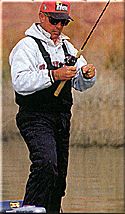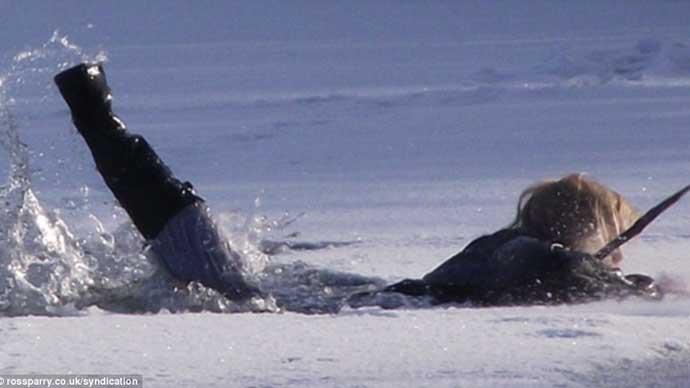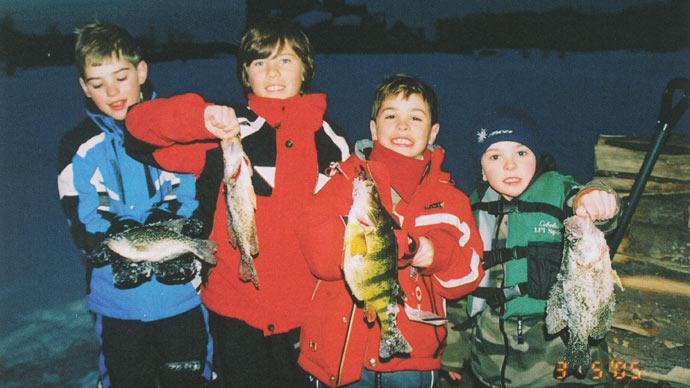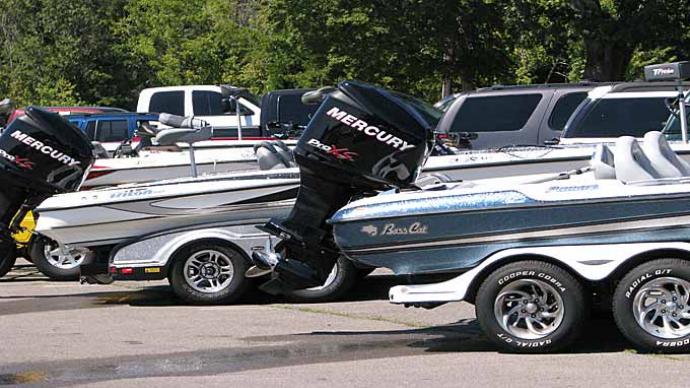| Important Tips |
|

Battling the elements and bass fishing go hand in hand. We leave the relative comfort of our houses and offices and place ourselves in Mother Nature's playground, but winter is almost upon us now, and with it comes the inherent dangers of colder weather and water temperatures. The threat of hypothermia and other cold-related injuries in such conditions is very real, so knowing how to prepare yourself for the cold is crucial in assuring that all your fishing trips are both comfortable and safe.
Though you may not realize this, what you eat and drink, the amount of rest that you get and what you wear, all play an important role in cold weather preparedness.
The first step in preparing for cold weather excursions starts in the kitchen. Your body is like a fine tuned machine, and when all its systems are properly running and maintained, it is able to withstand and compensate for a variety of external temperatures and conditions. The kitchen is where you get your fuel. Many engines require a certain grade of fuel to keep them running in good condition, and your body is the same. The fuel you use in your body directly effects your performance and the way your body functions. Especially in the cold, your body needs more of the "higher" grade fuels to keep it going. Complex carbohydrates such as those found in rice, beans, breads and pastas, are excellent sources of energy because they can be stored and then used when needed.
Drinking the correct amount of water (almost a gallon a day) is another aspect of eating right that can't be overlooked. Water acts as a transport system for your body, it moves helpful nutrients to where they are needed, and helps "flush out" waste materials and contaminant's that may be harmful. It is also essential in temperature regulation.
The next element in cold weather preparation, is getting plenty of rest. The optimal rest requirement is eight hours in a twenty four hour period. Sleep acts as the maintenance shop for your body. While you sleep, the different systems in your body repair themselves and are "recharged." In colder weather, staying "charged" is that much more important since you expend more trying to stay warm.
Just as important as getting rest, eating right and drinking lots of water, is wearing the right clothing. Both the materials they are made from and the way they are worn determine how well they protect you from the elements.
The best way to dress for any temperature is in layers. Also, your clothes should not fit too tightly since the warmed air that gets trapped between the layers is what keeps you warm. The National Ski Patrol suggests a four-layer system.
Since as high as 70 percent of your body heat can be lost through your head, the first thing you should put on is a hat. Even if it's just a baseball cap, it's surprising how much heat that one layer can retain. For colder temperatures, a fleece, or wool stocking cap may be needed. One idea is to take both a baseball cap and a stocking cap, so if the temperature changes, you can change your hat with it.
The next layer is underwear; what you wear closest to your skin. It's important to wear something that will wick perspiration away from your body. Water on your skin will begin cooling you down quite rapidly. The best materials are wool, and many of the newer synthetics. Cotton is the worst because once it gets wet it loses almost all insulating properties and takes a long time to dry. A pair of synthetic thermals is a wise choice.
You may also want a pair of gloves. Get some that fit well and keep your hands dry.
The second layer consists of your shirt and pants. Again, wool is recommended and works well for both, but a pair of jeans and flannel shirt will do. You want materials that are breathable and will allow the moisture coming from your body to escape.
The third layer is the outer layer or shell, what most of us would consider a jacket or coat. It should be relatively light, wind and water repellent, and breathable. This is the layer that will protect you most from the elements. Water repellent pants or bibs are also recommended. One of the keys to staying warm is staying dry.
The fourth and last layer is the insulating layer. This is your "extra" layer and should consist of a thick wool sweater or synthetic fleece to be worn under the shell. Although you may not need it on every occasion, it is important to have it just in case. Sweaters or fleece jackets can be stored in a plastic bag or other dry container until needed. The key to safety is being prepared.
One thing that many people overlook are their eyes. While flying across a lake in a boat you can experience winds of over 70 mph. With the right amount of wind and cold, the cornea of your eyes can actually freeze, causing distorted vision and damage. A pair of ski goggles will help protect your eyes from freezing and debris.
There are a considerable number of hazards to consider when fishing in the winter cold, following these tips will make your trip more enjoyable and safer too.
But don't let the cold keep you indoors, get on out there, this is a great time for trophy bass.
How To Prevent and Treat Hypothermia
By Dr. Newbold M.D.
The cold of winter brings many physical challenges with which anglers must contend. The human body has some preventative measures to protect it from cold and the heat, but in reality, it's not very efficient at either.
The Army uses an acronym to describe the best methods of dress for winter: C.O.L.D. The C stands for clean, emphasizing the fact that clean clothes are more effective for creating warmth. The 0 stands for open, vital for allowing sweat to dissipate, The L is for loose, vital for heat retention. The D is for dry, which limits heating loss. This is excellent advice.
When preparing to head out into a frigid environment, the type of materials you wear are also important. Many new materials on the market are very effective in cold weather. Gortex, Thinsulate, taslanized nylon and Flectalon are superb for outdoor wear.
Factors to consider when choosing clothing for outdoor wintertime activities are fairly simple. Thicker, quick drying materials, such as wool are great, but tightly knit nylon is best. You also need to consider materials that are wind resistant and water repellent.
Always wear a cap or hat when venturing out into the cold. The head and neck do not respond well to frigid temperatures and a large portion of body heat escapes through these areas.
When the temperature dips, the blood vessels of the body start to restrict in order to conserve body heat. Conversely, when it is hot, the vessels expand to release heat through the skin. While this has some effectiveness, it also can cause greater problems with frostbite on the hands, feet, ears and nose because of the lack of circulation. Make sure to protect these areas in extreme temperatures. Any time your body temperature drops below 94 degrees, you will have problems.
One of the first signs of physical problems is when your body starts to shiver. This is how the body tries to generate more heat. When the body temperature drops below 89 degrees, you can lose this protection and be in danger of hypothermia.
The number one reason people get into trouble with hypothermia, is due to alcohol, Never drink anything with alcohol when spending long periods of time doing outdoor activities. Your body response to weather conditions diminishes with alcohol and you may not realize you're getting cold.
Preventing hypothermia starts with getting plenty of rest prior to going out and combining that with an excellent nutrition program. People who are physically fit perform better in severe weather because their bodies utilize energy better. It's also a good idea to pack high-carbohydrate foods and simple sugars to use during the course of the day. Candy bars, breads and sandwiches work very nicely.
In case you or your partner falls in the water or is experiencing problems with hypothermia, here are a few things to remember: Immediately remove ALL wet clothes and wrap them up in dry clothing. You may even have to use your own body heat to help warm them. Hot packs placed on the feet, in the armpits and hands will help to slowly increase body temperature - and slowly is the key. If someone is suffering from hypothermia and you can get him or her to a bathtub, slowly rewarming the body by placing them in 104 to 108 degree water, is highly effective. Water warmer than this can damage the skin and the body's ability to heat.
Remember, it's always a good idea to keep heating packs in your fist aid kit at all times. They can be purchased at most outdoor retail outlets.
Reprinted with permission from Bass West Magazine




